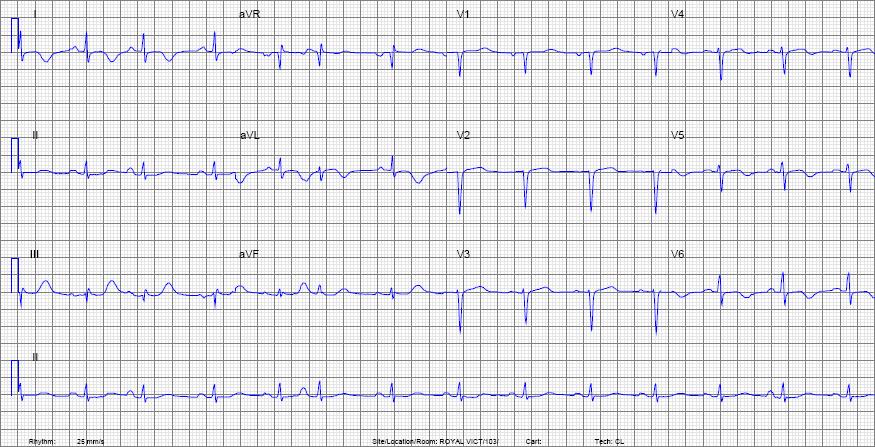
The same pacing foci discussed in the previous tutorial may become irritable and they may pace even when they should be suppressed by the SA node. This means they may fire any time during the cardiac cycle causing premature contractions of the atrial or ventricles.
They may even begin pacing well outside their normal intrinsic range - causing a tachycardia. In this tutorial we will discuss only premature contractions. Tachycardias generated by irritable foci will be discussed in future tutorials.
An atrial focus that fires prematurely will produce an early P'-wave that may have a different shape from the P-waves generated by the SA node. This premature P'-wave will cause contraction of the atria.
The premature P'-wave may or may not be conducted down through the AV node into the ventricles, to produce a QRS and cause the ventricles to contract. We call this a Premature Atrial Contraction (PAC). If the premature P'-wave occus right after a QRS, the AV node may still be depolarized from the previous beat and the P'-wave may be blocked. In this case, the P'-wave will occur without being followed by a QRS.

| Rate | Slightly irregular with an average rate around 84 |
| Rhythm | Repeated early P'-waves - note how the 2nd and 5th P-waves are early and have a different morphology from the other P-waves. |
It is also important to note that the P'-wave may arrive at the AV node at a time when one of the bundle branches of the ventricular conduction system is repolarized, but the other is not. This leads to aberrant conduction (a sloppy transmission of the depolarization wave to the muscle of the ventricle) in the ventricles and a slightly widened QRS.
Irritable junctional foci can produce a premature contraction that may look similar to a PAC. Since the focus in question is in the AV node, the wave of depolarization travels upward to the atrial and downward to the ventricles. If the upward moving P'-wave is not blocked, then it will depolarize the atria and cause an atrial contraction. Since the P'-wave is travelling from the AV node toward the SA node (the reverse of the usual), the P'-wave is inverted.
Additionally, since the wave of depolarization travels upward to the atria and downward to the ventricles at nearly the same time, the P'-wave and the QRS produced by such an event are usually very close together.
An irritable focus firing early in the ventricles will cause ventricular depolarization and contraction. Since the wave of depolarization is not travelling down the conduction system neatly as it was designed to do, the depolarization wave is "sloppy" and the QRS is significantly widened.

| Rate | 120bpm - note how the P-waves are on the back of the T-waves. This happens when the heart is beating fast. |
| Rhythm | Regular with 2 PVCs (and a third just visible at the end of the tracing). |
From the discussion above it is clear that: